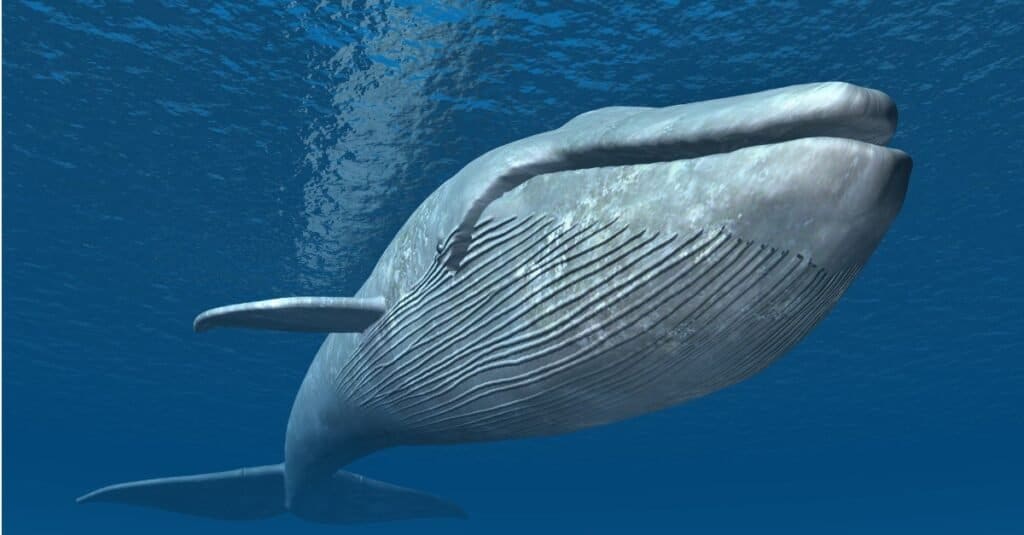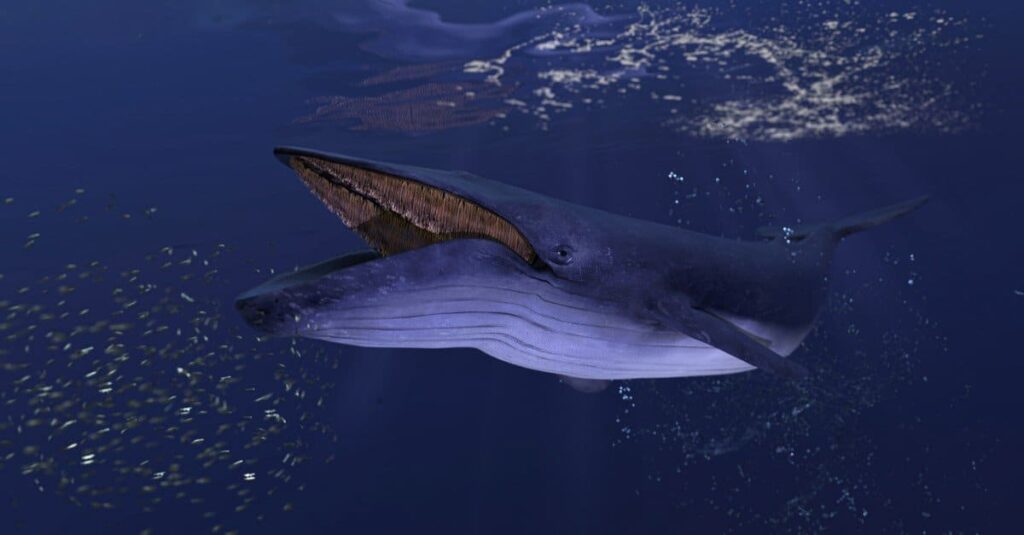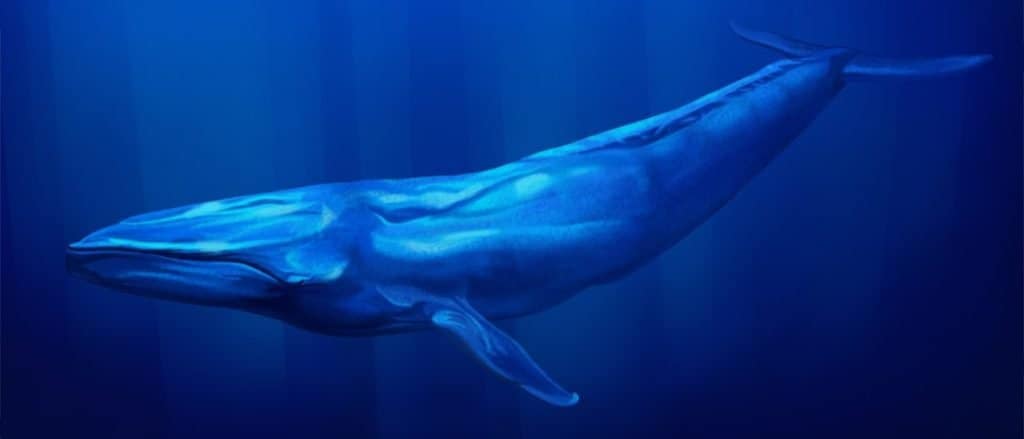Blue whales are magnificent gentle giants of the ocean. They can grow up to 100 feet in length, though they average around 70 feet. These ocean giants make beautiful and ethereal sounds that filter through the ocean, and they are the world’s largest mammals. But are blue whales endangered? Read on to find out!
How Many Blue Whales Are Left?
Comparing the current number of blue whales to what was present in the 19th century, you’d observe that there’s been a tremendous decline in their population. We’re talking about an 89 to 97% decline!
There are around 25,000 blue whales in the world today. This number could have you thinking that it’s a lot, but not when you compare it to about 350,000 blue whales in existence just 200 years ago.
Are Blue Whales Endangered?

Blue whales are classified as endangered by the IUCN.
©Andrew Sutton/Shutterstock.com
Yes, blue whales are endangered. As of 2022, blue whales are classified as endangered by the IUCN, the International Union for Conservation of Nature. Being classified as endangered means that they are at risk of total extinction if drastic measures are not taken.
Blue whales are actually protected under the Marine Mammal Protection Act. This act states that for certain marine mammals, you cannot take or import them, including parts of them or products produced from them.
Other animals included are the sea otter, walrus, polar bear, dugong, and manatee. It is essential that this law exists so that poachers or hunters are not openly hunting animals that are just struggling to survive.
Why Are Blue Whales Endangered?

Blue whales are endangered due to past whaling.
©iStock.com/MR1805
The World Wildlife Fund states that blue whales are endangered because of environmental changes often triggered by the pollution of toxic chemicals and garbage.
That’s just one reason blue whales are endangered. Part of it begins with the history of the blue whale. The Inuit, indigenous people of the arctic, hunted and utilized blue whales appropriately. They used whale bones to build houses, ate the blubber, and used their oils. They used every part of a blue whale, and it was important for their culture to help them survive.
The Inuit people are not why blue whales are endangered, though. Western people say that blue whales were enjoyable to hunt and produced many products for which they could make money. Some of those products were lamp oil, soap, perfume, makeup, and more. So whalers began to hunt them around the end of the 18th century.
The population of blue whales began to drop drastically in the coming years until we arrived at our current day and age, with around 15,000 mature blue whales in the wild.
The reason for this sudden decline could be attributed to the invention of the harpoon gun. Oliver Allen of Norwich invented the harpoon gun to be explicitly used in the capture and killing of blue whales. The Allen gun was the first that made it almost easy to kill blue whales.
Is Ship Strikes a Reason Blue Whales are Endangered?

No, ship strikes are not a strong reason why blue whales are endangered.
©Danny Sullivan/Shutterstock.com
A reason commonly believed why blue whales are endangered is ship strikes. An article in Marine Mammal Science states that ship strikes actually are not a huge contributor to their endangered status. Though, it does state that ship strikes are above the legal limit that was set by the United States.
So yes, ship strikes contribute to blue whale loss, but studies indicate that it is not a huge factor. Instead, it has to do with the population density of blue whales. Density dependence seems to be a huge factor.
Density dependence is when the population growth is affected by the density of a population. If the population itself goes down, it is harder to grow a new population and sustain it.
Ship strikes, of course, do cause immediate damage to animals and the population. There are definitely more than there should be, but overall, that is not why blue whales are endangered.
What Else Harms Blue Whale Populations?

Overfishing of krill harms blue whale populations.
©bekirevren/Shutterstock.com
Initially, the populations were just decimated by whaling, so they are at such low levels today. That low-density population itself causes a struggle for whales to grow in amount because they are dependent on population size. It takes 10-15 years for a blue whale to reach full maturity and reproductive age.
Blue whales’ diets almost entirely consist of krill. Krill are tiny crustaceans and populate the ocean in heavy numbers. Blue whales inhale the seawater and filter it through baleen plates to catch the krill to eat.
Part of the issue is that krill, which used to be so common in our ocean, is becoming less common. Since 1970 the population of krill in the sea has dropped by almost 80%, which spells out bad news for the blue whale.
The reason krill have declined is simple enough; global warming. At least, that’s what has killed 40% of the krill population, according to an article in newsela. The other reason krill populations are declining is overfishing.
We have been overfishing krill due to new technologies and krill fisheries that don’t care about disrupting the ocean climate. More krill than ever before can easily be caught now, and it is causing issues.
The climate change aspect means ice is melting, and the ice is where algae and plankton that krill eat live. Krill are the main food source of the blue whale, so the declining population starves out blue whales that are attempting to reach sexual maturity.
Are Blue Whales Carnivores?

Blue whales are carnivores.
©Atomic Roderick/Shutterstock.com
Since blue whales eat krill and other fish they may inhale with the seawater, they are, in fact, considered carnivores. This may come as a surprise to people who don’t realize krill are crustaceans. Just because the blue whale eats small animals doesn’t mean they don’t count.
Blue whales have also been known to consume squid and octopus as well. They’ve probably eaten fish now and again, too.
Blue whales are fantastic mammals, weighing up to 300,000 pounds in their prime, making them the largest mammals in the world. It makes sense that they would be carnivores, consuming what they must to survive in a harsh world.
This beautiful species should not be endangered, but it is, so we should keep doing what we must to ensure that it survives in the coming years.
The photo featured at the top of this post is © iStock.com/MR1805
Thank you for reading! Have some feedback for us? Contact the AZ Animals editorial team.






